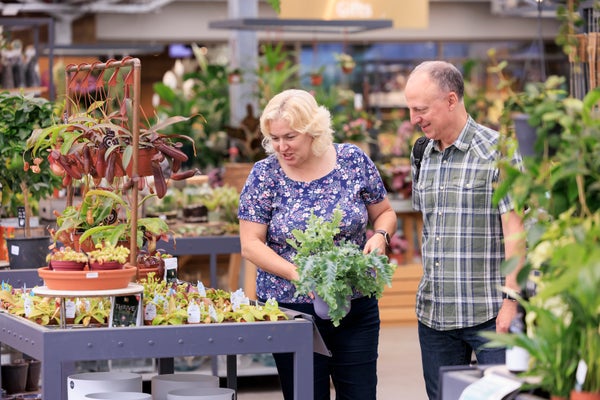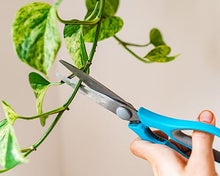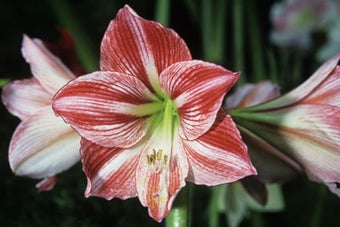
Quick facts
Our top 5 houseplants:
Best easy-care succulent - Crassula ovata (jade plant or money tree)
Best year-round flowers - Streptocarpus hybrids (Cape primrose)
Best hanging plant - Ceropegia linearis subsp. woodii(string of hearts)
Best winter colour - Schlumbergera hybrids (Christmas cactus)
Best gift to give a friend - Spathiphyllum wallisii(peace lily)
How to choose houseplants
Healthy, thriving houseplants are not only a joy to look at, they can also help to boost our mental wellbeing and improve our indoor air quality. Whether you want a bold structural statement, a lush jungle vibe or a delicate floral display, there are lots of beautiful houseplants to suit. However, with such a wide range of options readily available, it can be hard to know where to start.
Our warm homes gives us the perfect chance to grow an exciting array of exotic plants that wouldn’t survive outdoors. But, conditions vary in different parts of our home. Not all our rooms offer consistent temperatures, and light levels will differ, depending on the size and direction of the windows. The air tends to be more humid in bathrooms, but drier in living rooms, especially in winter when the central heating is on.
So the main priority is to select houseplants to suit your location, to ensure they will thrive and look their best without too many problems or excessive maintenance.
For more quick tips on buying a houseplant, see our handy video guide:
Getting started
If you are just beginning to grow indoor plants, selecting an easy-care houseplant is the obvious first choice.
Find out more >
Providing the right conditions
Indoor growing conditions can vary just as much as outdoors in a garden – the three key aspects to bear in mind are light, and temperature.
Amount of light
Light levels are very important to plants, as is the type of light (full sun, bright indirect light and shade). Bear in mind that light will fluctuate across the day, and at different times of year. A spot with direct sun in summer will often cause leaf discoloration and scorching, unless the light is filtered by sheer curtains or blinds. In winter, that location may be a prime growing spot, when the sun is weaker and the days are shorter.
Many plants would struggle in locations set back from windows, where they get very little light. North-facing windowsills can be tricky too, especially in winter when day lengths are reduced.
Domestic lighting doesn’t provide suitable light for plant growth, although artificial grow lamps are widely available if you need to provide additional brightness. These can be expensive, both to buy and run, and aren’t ideal lighting for most homes.
See the different levels of light houseplants need in our video guide:
Humidity levels
Air humidity varies in different rooms. A bathroom or kitchen will often have high humidity, whereas a living room, especially with the central heating on, will tend to have low humidity.
Many popular tropical plants, such as orchids, need humid air, to mimic their natural growing conditions, so will suffer in a drier atmosphere – their foliage may turn brown and they may fail to thrive. Few houseplants, apart from cacti and , like very dry situations.
There are various easy ways to raise the air humidity around your houseplants – see our video guide for tips:
Temperature
Room temperature can vary from season to season, and between day and night. Locations that become very hot from the direct summer sun or from a nearby radiator can lead to leaf damage. Plants left in sun rooms or conservatories over winter can suffer if night temperatures are too cold. Draughts can be damaging too, and hallways tend to be a particular problem area.
So it’s a good idea to check the temperature over 24 hours in different rooms, so you know how much it fluctuates. Consider moving your plants around during the year to make the most of available light and warmth.
For more on growing houseplants successfully, see our guides:
Recommended houseplants by location
Choosing the right houseplants can transform your home, but it’s essential to match the plant to the specific conditions of each room. Whether you have a sunny living room, a shaded bedroom, or a humid bathroom, this guide will recommend the best houseplants for every location, ensuring they thrive and beautify your space.

For bright sunny rooms or locations such as a south-facing windowsill or sunny conservatory where both light levels and temperatures can get high, be sure to pick a true sun-loving houseplant that will really thrive in the conditions.

Love houseplants but worried your indoor space is too dark? Never fear, there are plenty of plants that will green up even the gloomiest room – from north or north-east facing windowsills to shaded conservatories.

Transform your bathroom into a lush oasis with the best houseplants that thrive in humid locations where temperatures can be cool.
Recommended houseplants for tricky environments
Houseplants can brighten any home, but some conditions are more challenging than others. This guide covers the best houseplants for low light with fluctuating temperatures, cool and bright spots, and unheated areas above freezing. Find the perfect plants to thrive in these tricky environments and bring your indoor spaces to life.
Best houseplants for low light and fluctuating temperatures


These plants can cope in locations such as a hallway or single-glazed room that could be centrally heated by day but cold and draughty at night.
- Chamaedorea elegans AGM (parlour palm)
- Chlorophytum comosum ‘Variegatum’ (v) AGM (spider plant)
- Chlorophytum comosum ‘Vittatum’ (v) AGM
- Epipremnum aureum AGM (Ceylon creeper)
- × Fatshedera lizei AGM (tree ivy)
- Ficus elastica (India rubber tree)
- Soleirolia soleirolii (mind-your-own-business) note: can become if grown outdoors
- Philodendron scandens AGM (heart-leaf)
- Sansevieria trifasciata (snake plant)
- Senecio macroglossus ‘Variegatus’ AGM
- Syngonium podophyllum AGM (nephthytis)
Best houseplants for cool, bright locations


These plants will be happy where the minimum winter night temperature is above freezing – such as in a sun room, unheated conservatory or enclosed porch.
Cacti and
- Aeonium arboreum ‘Atropurpureum’ AGM (dark purple houseleek tree)
- Aeonium haworthii AGM
- Aeonium tabulaeforme AGM
- Aeonium undulatum
- Agave parryi AGM
- Agave utahensis AGM
- Aloe humilis (spider aloe)
- Aloe variegata AGM ( candelabra aloe)
- Aloe vera AGM
- Cereus uruguayanus
- Opuntia cantabrigiensis
- Opuntia compressa
- Opuntia fragilis (brittle cactus)
- Opuntia polyacantha
- Sempervivum arachnoideum AGM (cobweb houseleek)
- Sempervivum calcareum
- Sempervivum ciliosum AGM
- Sempervivum tectorum AGM (common houseleek)
Climbing/trailing hsoueplants
- Ampelopsis brevipedunculata ‘Elegans’ (v)
- Chlorophytum comosum ‘Variegatum’ (v) AGM (spider plant)
- Chlorophytum comosum ‘Vittatum’ (v) AGM
- Cissus antarctica AGM (kangaroo vine)
- × Fatshedera lizei AGM (tree ivy)
- Hedera helix (ivy)
- Jasminum mesnyi AGM (primrose jasmine)
- Jasminum polyanthum AGM (many-flowered jasmine)
- Saxifraga stolonifera AGM (strawberry saxifrage)
- Tolmiea menziesii AGM (pickaback plant)
- Tradescantia fluminensis ‘Quicksilver’ AGM
- Tradescantia zebrina AGM (silver inch plant)
Shrubs and
- Araucaria heterophylla AGM (Norfolk Island pine)
- Aspidistra elatior AGM (aspidistra)
- Aucuba japonica (spotted laurel)
- Buxus sempervirens (common box)
- Campanula isophylla AGM (falling stars)
- Euonymus japonicus (evergreen spindle)
- Fatsia japonica AGM
- Grevillea robusta AGM
- Pelargonium
- Schefflera actinophylla AGM (umbrella plant)
- Soleirolia soleirolii (mind-your-own-business) note: can become invasive if grown outdoors
- Trachycarpus fortunei AGM (Chusanl palm)
Ferns
- Adiantum hispidulum (maidenhair fern)
- Adiantum raddianum AGM
- Asparagus densiflorus ‘Myersii’ AGM (foxtail fern)
- Asparagus densiflorus Sprengeri Group AGM (emerald feather)
- Asparagus falcatus
- Asplenium bulbiferum Forst.f. (hen and chicken fern)
- Asplenium nidus AGM (bird’s nest fern)
- Asplenium scolopendrium AGM (hart’s tongue fern)
- Cyrtomium falcatum AGM (Japanese holly fern)
- Nephrolepis exaltata AGM (sword fern)
- Pteris cretica AGM
- Pteris tremula
Best houseplants for unheated locations above freezing


- Camellias – culltivars of Camellia japonica andCamellia × williamsii
- Clivia miniata AGM
- Crinum × powellii AGM
- Pseudosasa japonica AGM
- Pleioblastus viridistriatus AGM
- Fargesia nitida
Best houseplants to give as gifts

Brighten someone’s day with a gift that grows. Garden writer Laetitia Maklouf shares her top five houseplant picks – perfect for friends and loved ones.















